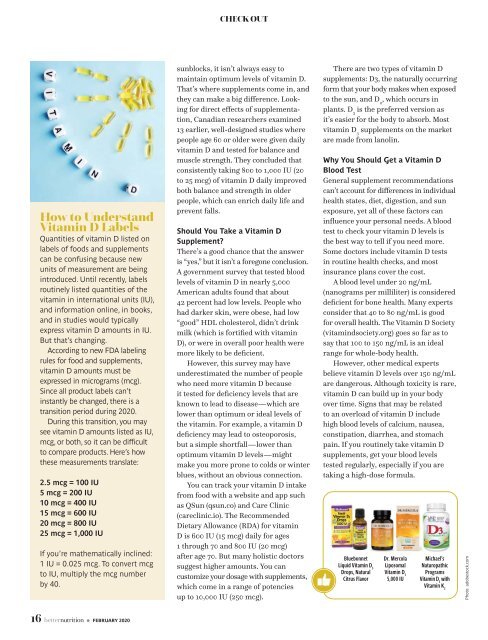You also want an ePaper? Increase the reach of your titles
YUMPU automatically turns print PDFs into web optimized ePapers that Google loves.
sunblocks, it isn’t always easy to<br />
maintain optimum levels of vitamin D.<br />
That’s where supplements come in, and<br />
they can make a big difference. Looking<br />
for direct effects of supplementation,<br />
Canadian researchers examined<br />
13 earlier, well-designed studies where<br />
people age 60 or older were given daily<br />
vitamin D and tested for balance and<br />
muscle strength. They concluded that<br />
consistently taking 800 to 1,000 IU (20<br />
to 25 mcg) of vitamin D daily improved<br />
both balance and strength in older<br />
people, which can enrich daily life and<br />
prevent falls.<br />
CHECK OUT<br />
How to Understand<br />
Vitamin D Labels<br />
Quantities of vitamin D listed on<br />
labels of foods and supplements<br />
can be confusing because new<br />
units of measurement are being<br />
introduced. Until recently, labels<br />
routinely listed quantities of the<br />
vitamin in international units (IU),<br />
and information online, in books,<br />
and in studies would typically<br />
express vitamin D amounts in IU.<br />
But that’s changing.<br />
According to new FDA labeling<br />
rules for food and supplements,<br />
vitamin D amounts must be<br />
expressed in micrograms (mcg).<br />
Since all product labels can’t<br />
instantly be changed, there is a<br />
transition period during <strong>2020</strong>.<br />
During this transition, you may<br />
see vitamin D amounts listed as IU,<br />
mcg, or both, so it can be difficult<br />
to compare products. Here’s how<br />
these measurements translate:<br />
2.5 mcg = 100 IU<br />
5 mcg = 200 IU<br />
10 mcg = 400 IU<br />
15 mcg = 600 IU<br />
20 mcg = 800 IU<br />
25 mcg = 1,000 IU<br />
If you’re mathematically inclined:<br />
1 IU = 0.025 mcg. To convert mcg<br />
to IU, multiply the mcg number<br />
by 40.<br />
16 • FEBRUARY <strong>2020</strong><br />
Should You Take a Vitamin D<br />
Supplement?<br />
There’s a good chance that the answer<br />
is “yes,” but it isn’t a foregone conclusion.<br />
A government survey that tested blood<br />
levels of vitamin D in nearly 5,000<br />
American adults found that about<br />
42 percent had low levels. People who<br />
had darker skin, were obese, had low<br />
“good” HDL cholesterol, didn’t drink<br />
milk (which is fortified with vitamin<br />
D), or were in overall poor health were<br />
more likely to be deficient.<br />
However, this survey may have<br />
underestimated the number of people<br />
who need more vitamin D because<br />
it tested for deficiency levels that are<br />
known to lead to disease—which are<br />
lower than optimum or ideal levels of<br />
the vitamin. For example, a vitamin D<br />
deficiency may lead to osteoporosis,<br />
but a simple shortfall—lower than<br />
optimum vitamin D levels—might<br />
make you more prone to colds or winter<br />
blues, without an obvious connection.<br />
You can track your vitamin D intake<br />
from food with a website and app such<br />
as QSun (qsun.co) and Care Clinic<br />
(careclinic.io). The Recommended<br />
Dietary Allowance (RDA) for vitamin<br />
D is 600 IU (15 mcg) daily for ages<br />
1 through 70 and 800 IU (20 mcg)<br />
after age 70. But many holistic doctors<br />
suggest higher amounts. You can<br />
customize your dosage with supplements,<br />
which come in a range of potencies<br />
up to 10,000 IU (250 mcg).<br />
There are two types of vitamin D<br />
supplements: D3, the naturally occurring<br />
form that your body makes when exposed<br />
to the sun, and D 2<br />
, which occurs in<br />
plants. D 3<br />
is the preferred version as<br />
it’s easier for the body to absorb. Most<br />
vitamin D 3<br />
supplements on the market<br />
are made from lanolin.<br />
Why You Should Get a Vitamin D<br />
Blood Test<br />
General supplement recommendations<br />
can’t account for differences in individual<br />
health states, diet, digestion, and sun<br />
exposure, yet all of these factors can<br />
influence your personal needs. A blood<br />
test to check your vitamin D levels is<br />
the best way to tell if you need more.<br />
Some doctors include vitamin D tests<br />
in routine health checks, and most<br />
insurance plans cover the cost.<br />
A blood level under 20 ng/mL<br />
(nanograms per milliliter) is considered<br />
deficient for bone health. Many experts<br />
consider that 40 to 80 ng/mL is good<br />
for overall health. The Vitamin D Society<br />
(vitamindsociety.org) goes so far as to<br />
say that 100 to 150 ng/mL is an ideal<br />
range for whole-body health.<br />
However, other medical experts<br />
believe vitamin D levels over 150 ng/mL<br />
are dangerous. Although toxicity is rare,<br />
vitamin D can build up in your body<br />
over time. Signs that may be related<br />
to an overload of vitamin D include<br />
high blood levels of calcium, nausea,<br />
constipation, diarrhea, and stomach<br />
pain. If you routinely take vitamin D<br />
supplements, get your blood levels<br />
tested regularly, especially if you are<br />
taking a high-dose formula.<br />
Bluebonnet<br />
Liquid Vitamin D 3<br />
Drops, Natural<br />
Citrus Flavor<br />
Dr. Mercola<br />
Liposomal<br />
Vitamin D 3<br />
5,000 IU<br />
Michael’s<br />
Naturopathic<br />
Programs<br />
Vitamin D 3<br />
with<br />
Vitamin K 2<br />
Photo: adobestock.com

















